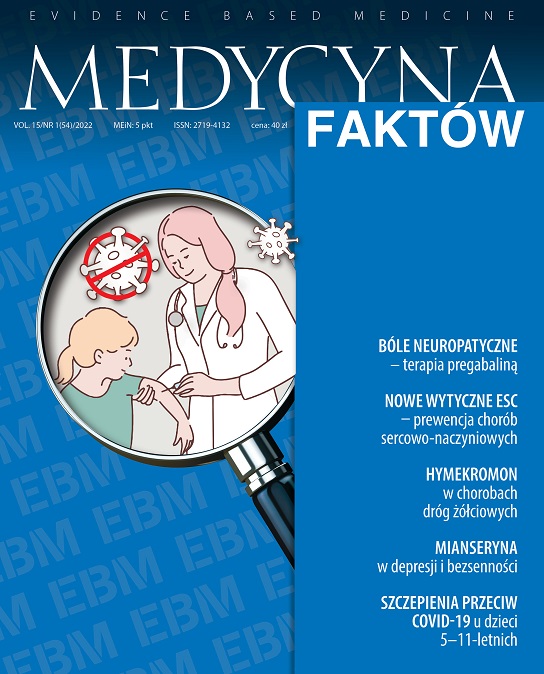The use of pregabalin in a patient with chronic neuropathic pain after oncological surgery – a case report Case report
Main Article Content
Abstract
Chronic postsurgical pain is a frequent iatrogenic complication and the consequence of surgical treatment of neoplastic disease. The risk of developing chronic postsurgical pain depends on the type of surgery, its extent, but also on the patients’ factors. Neuropathic pain may occur in 50% of patients with chronic postsurgical pain and can only be treated symptomatically, both with pharmacotherapy and non-pharmacological methods. The recommended drugs are antiepileptic drugs, antidepressants, opioid analgesics and topical drugs. These drugs have proven their effectiveness in the population of patients with neuropathic pain unrelated to cancer treatment, but there are still no high-quality studies assessing their effectiveness in patients with chronic postsurgical pain resulting from oncological surgery. Studies in small groups of patients available in the literature confirm the effectiveness of antiepileptic and antidepressant drugs in this group of patients, what is observed in clinical practice as well. The article presents a case of a patient with severe neuropathic pain in the course of chronic postsurgical pain who was successfully treated with pregabalin in combination with tramadol and paracetamol.
Article Details
Copyright © by Medical Education. All rights reserved.
References
2. Werner MU, Kongsgaard UE. Defining persistent post-surgical pain: is an update required? Br J Anaesth. 2014; 113: 1-4.
3. Perkins FM, Franklin JS. Prediction and Prevention of Persistent Post-Surgical Pain. In: Benzon H, Rathmell J, Wu CL et al. (ed). Practical management of pain. 5th Edition – 2014 Mosby Elsevier Inc. Philadelfia: 298-303.e2
4. Richebé P, Capdevila X, Rivat C. Persistent Postsurgical Pain: Pathophysiology and Preventative Pharmacologic Considerations. Anesthesiology. 2018; 129(3): 590-607.
5. Chapman CR, Vierck CJ. The Transition of Acute Postoperative Pain to Chronic Pain: An Integrative Overview of Research on Mechanisms. J Pain. 2017; 18(4): 359.
6. Haroutiunian S. The neuropathic component in persistent postsurgical pain: A systematic literature review. Pain. 2013; 154: 95-102.
7. Borsook D, Youssef AM, Simons L et al. When pain gets stuck: the evolution of pain chronification and treatment resistance. Pain. 2018; 159(12): 2421-36.
8. Przeklasa-Muszyńska A, Dobrogowski J, Kocot-Kępska M. Kliniczna ocena chorego z bólem. In: Dobrogowski J, Wordliczek J, Kocot-Kępska M (ed). Ból. Wiedza w kieszeni. Termedia Wydawnictwa Medyczne, Poznań 2020: 25-34.
9. Finnerup NB, Attal N, Haroutounian S et al. Pharmacotherapy for neuropathic pain in adults: a systematic review and meta-analysis. Lancet Neurol. 2015; 14(2): 162-73. http://doi.org/10.1016/S1474-4422(14)70251-0.
10. Fallon M, Giusti R, Aielli F et al.; ESMO Guidelines Committee. Management of cancer pain in adult patients: ESMO Clinical Practice Guidelines. Ann Oncol. 2018; 29(suppl 4): iv166-iv191. http://doi.org/10.1093/annonc/mdy152.
11. Chincholkar M. Analgesic mechanisms of gabapentin and effects in experimental pain models: a narrative review. Br J Anaesth. 2018; 120: 1315-34.
12. Verma V, Singh N, Singh Jaggi A. Pregabalin in neuropathic pain: evidences and possible mechanisms. Curr Neuropharmacol. 2014; 12: 44-56.
13. Jordan RI, Mulvey MR, Bennett MI. A critical appraisal of gabapentinoids for pain in cancer patients. Curr Opin Support Palliat Care. 2018; 12(2): 108-17.
14. Derry S, Bell RF, Straube S et al. Pregabalin for neuropathic pain in adults. Cochrane Database Syst Rev. 2019; 1: CD007076.
15. Charakterystyka produktu leczniczego: pregabalina.
16. Szczudlik A, Dobrogowski J, Wordliczek J et al. Diagnosis and management of neuropathic pain: Review of literature and recommendations of the Polish Association for the Study of Pain and the Polish Neurological Society – Part one. Neurol Neurochir Pol. 2014; 48: 262-71.
17. Lussier D. Pain Pharmacotherapy in Older Patients. In: Sommer CL, Wallace MS, Cohen SP et al (ed). Pain 2016: Refresher Courses, 16th World Congress on Pain: 349-56.
18. Markman JD, Jensen TS, Semel D et al. Effects of Pregabalin in Patients with Neuropathic Pain Previously Treated with Gabapentin: A Pooled Analysis of Parallel-Group, Randomized, Placebo-controlled Clinical Trials. Pain Pract. 2017; 17(6): 718-28. http://doi.org/10.1111/papr.12516.
19. Dworkin RH, O`Connor AB, Audette J et al. Recommendations for the pharmacological management of neuropathic pain; an overview and literature update. Mayo Clin. Proc. 2010; 85(3 suppl): S3-S14.
20. Holbech JV, Jung A, Jonsson T et al. Combination treatment of neuropathic pain: Danish expert recommendations based on a Delphi process. J Pain Res. 2017; 10: 1467-75.
21. Arnold LM, McCarberg BH, Clair AG et al. Dose-response of pregabalin for diabetic peripheral neuropathy, postherpetic neuralgia, and fibromyalgia. Postgrad Med. 2017; 129(8): 921-33. http://doi.org/10.1080/00325481.2017.1384691.

